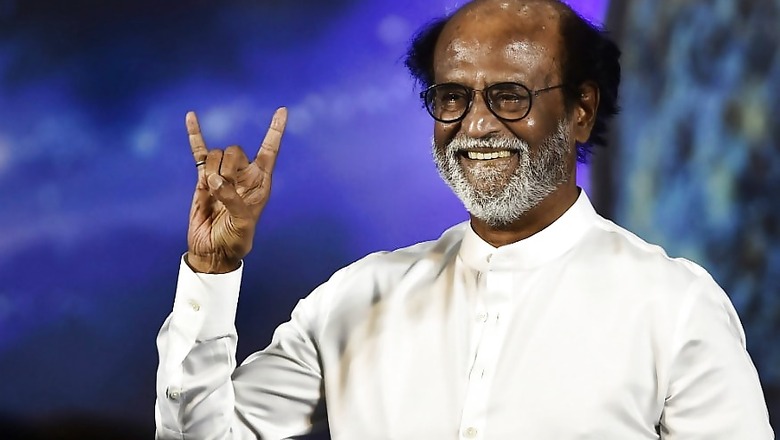
views
Tamil cinema superstar and political aspirant Rajinikanth’s speech at the 50th anniversary of Thuglak, the Tamil magazine founded in 1970 by the late Cho Ramaswamy, has given a controversial 1971 event present-day political context.
In his speech, Rajini had recounted that an issue of Thuglak was banned in 1971 after it published a cover story with pictures on the denigrating and obscene portrayal of Hindu gods Ram and Sita at the ‘Superstition Eradication Conference’ led by Periyar EV Ramasawmy, the father of the Dravidian movement, in Salem city.
Rajini recounted the Thuglak ban while talking about how Cho Ramaswamy and the magazine’s stature grew because it challenged the DMK in this instance, and went against the Congress during the Emergency imposed by Indira Gandhi.
The recollection of the 1971 event has present political context for Rajini, the BJP and Tamil Nadu.
Firstly, the portrayal of Hindu gods with symbolic assaults on idols or incendiary and abusive language was not uncommon for the Dravidar Kazhagam (DK), which was created in 1944 with Periyar as its leader. He saw it as a social reform movement with rationalist beliefs and an agenda to fight superstition and Brahmanical hierarchy. He had parted ways with the Congress and launched a self-respect movement in 1925 and this movement merged with the Justice Party to form the Dravidar Kazhagam in 1944.
Since its inception, it was a fierce social force and used virulent language, especially against Brahmins and superstitions, to establish its presence and propagate its core beliefs.
While Periyar refused to engage in electoral politics and wanted the Dravidar Kazhagam to remain a social movement, his disciple CN Annadurai parted ways to launch the Dravida Munnetra Kazhagam as an electoral force in 1957.
Ever since Annadurai led the DMK to power in 1967, Tamil Nadu has been ruled only by the DMK or its further offshoot, the AIADMK, and both parties regarded Periyar as the ideological father. This has meant that there has been no opposition or force to question, criticise or challenge Dravidian ideological positions.
While Annadurai grew up in Periyar’s strongly atheist Dravidar Kazhagam, he later explained his position as ‘one god, one race’. This was a departure and moderation from a fierce ideological atheist position to suit electoral compulsions and towards larger social acceptance.
The compromise was necessary because despite the victory of Dravidian politics, Tamil Nadu has remained a deeply religious state and a majority of DMK leaders themselves are believers. The use of fiery language and obscene demonstration to challenge gods and goddesses would not have electoral dividends.
However, the core ideological narrative challenges Ram as the god and portrays Ravan as the hero, and, unlike in the rest of India, that narrative does not receive any fierce opposition in Tamil Nadu. This is where the BJP wants to step in.
In is in this context that Rajinikanth’s recollection of the Thuglak incident sparks a wider political debate. Is he emerging and positioning himself as a voice to challenge the narrative that Periyar is beyond challenge?
There was and has been no political or electoral force to challenge the Dravidar Kazhagam, DMK or Periyar at an ideological level. Given that the Congress surrendered to Dravidian parties, there has been no alternate position in the state.
The BJP along with fringe Right-wing groups has made attempts at provoking the issue, but have no ground support. Dravidian parties have an extremely strong organisation structure at the grassroots and this structure has made Hindutva a non-entity in the state.
During the 1999-2004 Atal Bihari Vajpayee-led NDA government, BJP local units could not push for a Tamil Nadu ideological agenda as the DMK was a crucial ally. In fact, this was the reason the state unit forced a break from the DMK and shifted to an alliance with Jayalalithaa.
Jayalalithaa was a classic irony to Dravidian politics. She was openly ritualistic, superstitious and a Brahmin. But she represented and led a party that was part of Periyar-descendant political formations.
Though her image did not adhere to Dravidian ideological values, and this was pointed out by the DMK, she was not an opponent of core Dravida ideology. She could not afford to be. In fact, this is why she refused an open alliance with the BJP in later years.
Given that there has never been a Dravidian versus anything fault-line in the state over the last four decades, the BJP is making efforts to slip in the ideological theme in the absence of powerful personalities in the state's polity and fill the narrative after the demise of Jayalalithaa and Karunanidhi.
However, in today’s context, such a fault-line would also fall into a communal versus secular narrative and will result in anyone questioning Periyar being branded ‘communal’.
It’s not clear if Rajini, who is yet to even launch a political party, would risk that, and if he does, the next election may actually show whether Dravidian ideology remains unanimously accepted or whether there is a challenger to it in the southern state.
(The author is a senior journalist. Views are personal)


















Comments
0 comment